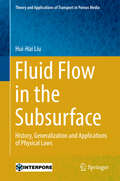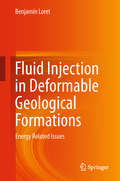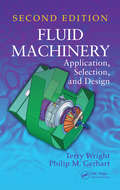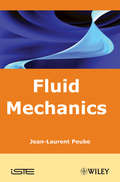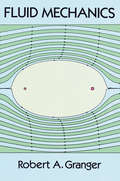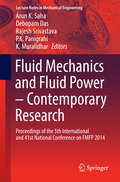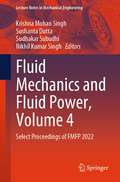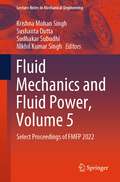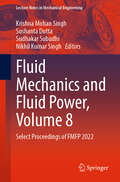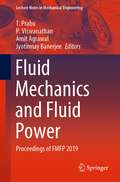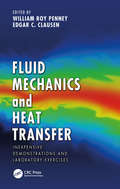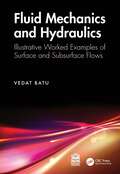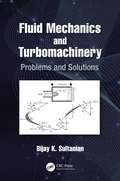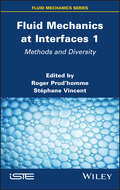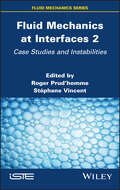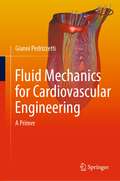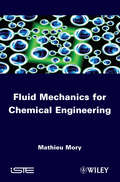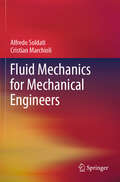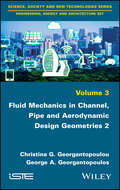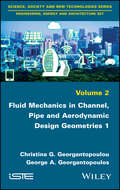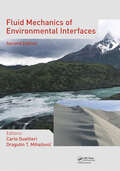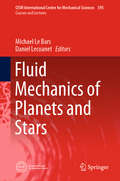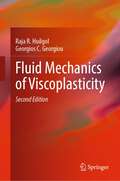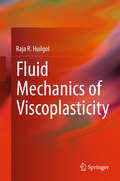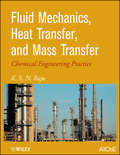- Table View
- List View
Fluid Flow in the Subsurface
by Hui-Hai LiuThis book presents a systematic attempt to generalize several fundamental physical laws related to subsurface fluid flow that are important for a number of contemporary applications in the areas of hydrogeology, reservoir engineering and rock mechanics. It also covers the history of discovering these physical laws, their respective scope of validity, and their generalizations or extensions. The physical laws discussed include Darcy s law, Darcy-Buckingham law and Hooke s law. Darcy s law is the fundamental law for subsurface fluid flow. For low-permeability media, it is not always adequate because of the strong fluid solid interaction. Though the Darcy-Buckingham law is often used for modeling subsurface multiphase flow, it is only valid under the local equilibrium condition. This condition does not hold in many cases, especially when fingering flow occurs. It is well known that subsurface fluid flow is coupled with mechanical deformation of subsurface media; in some applications, this coupling can play a dominant role. The continuum-scale elastic deformation of natural rock, however, does not always follow the traditional form of Hooke s law. The book also presents applications of the proposed generalizations of the physical laws to several important engineering projects. "
Fluid Injection in Deformable Geological Formations: Energy Related Issues
by Benjamin LoretThis book offers an introduction to the geomechanical issues raised by both the extraction of actual and potential energy resources, and by the treatment of the ensuing environmental concerns. Discussions of the operations of injection of fluids into, and withdrawal from, geological formations link the chapters, each devoted to a particular technical aspect or scientific issue, or to a particular energy resource.Subjects are ordered according to their industrial applications, including enhanced oil and gas recovery, gas hydrates, enhanced geothermal systems, hydraulic fracturing, and carbon dioxide sequestration. An overview of the industrial, research and simulation aspects for each subject is provided. Fluid Injection in Deformable Geological Formations will be of interest to academic and industrial researchers in a wide variety of fields, including computational mechanics, civil engineering, geotechnical engineering and geomechanics, engineering seismology, petroleum engineering, reservoir engineering, and engineering geology.
Fluid Machinery: Application, Selection, and Design, Second Edition
by Terry Wright Philip GerhartPublished nearly a decade ago, Fluid Machinery: Performance, Analysis, and Design quickly became popular with students, professors, and professionals because of its comprehensive and comprehensible introduction to the fluid mechanics of turbomachinery. Renamed to reflect its wider scope and reorganized content, this second edition provides a more l
Fluid Mechanics
by Jean-Laurent PuebeThis book examines the phenomena of fluid flow and transfer as governed by mechanics and thermodynamics. Part 1 concentrates on equations coming from balance laws and also discusses transportation phenomena and propagation of shock waves. Part 2 explains the basic methods of metrology, signal processing, and system modeling, using a selection of examples of fluid and thermal mechanics.
Fluid Mechanics (Dover Books on Physics)
by Robert A. Granger"The mixture of prose, mathematics, and beautiful illustrations is particularly well chosen." -- American ScientistThis monumental text by a noted authority in the field is specially designed to provide an orderly structured introduction to fluid mechanics, a field all too often seen by students as an amorphous mass of disparate equations instead of the coherent body of theory and application it should be. In addition, the book will help upgrade students' mathematical skills as they learn the fundamentals of fluid mechanics.The text presents a unified method of analysis that poses fluid mechanics problems in precise mathematical language without becoming stiff or unnecessarily rigorous. This method involves three steps: First, the text carefully defines each problem so the student knows what is given and what is missing. Second, each chapter treats the physical aspects of the problems so the student can visualize how things work in the real world. Third, the text represents the physical model by appropriate mathematical symbols and operators, collects these into equations, and then solves them. The result is a superb learning and teaching process that covers everything the engineer needs to know -- nature of fluids, hydrostatics, differential and integral equations, dimensional analysis, viscous flows, and other topics -- while allowing students to see each element in its relation to the whole.Each chapter contains numerous examples incorporating problem-solving techniques, demonstrations to illustrate topical material, study questions, boxed equations of significant results, appropriate references to supplementary materials and other study aids. Over 760 illustrations enhance the text. This volume will be an indispensable reference and resource for any student of fluid mechanics or practicing engineer.
Fluid Mechanics and Fluid Power – Contemporary Research
by Rajesh Srivastava Arun K. Saha Debopam Das P. K. Panigrahi K. MuralidharThis volume comprises the proceedings of the 42nd National and 5th International Conference on Fluid Mechanics and Fluid Power held at IIT Kanpur in December, 2014. The conference proceedings encapsulate the best deliberations held during the conference. The diversity of participation in the conference, from academia, industry and research laboratories reflects in the articles appearing in the volume. This contributed volume has articles from authors who have participated in the conference on thematic areas such as Fundamental Issues and Perspectives in Fluid Mechanics; Measurement Techniques and Instrumentation; Computational Fluid Dynamics; Instability, Transition and Turbulence; Turbomachinery; Multiphase Flows; Fluid‐Structure Interaction and Flow‐Induced Noise; Microfluidics; Bio‐inspired Fluid Mechanics; Internal Combustion Engines and Gas Turbines; and Specialized Topics. The contents of this volume will prove useful to researchers from industry and academia alike.
Fluid Mechanics and Fluid Power, Volume 4: Select Proceedings of FMFP 2022 (Lecture Notes in Mechanical Engineering)
by Sudhakar Subudhi Krishna Mohan Singh Sushanta Dutta Nikhil Kumar SinghThis book comprises select peer-reviewed proceedings of the 9th International and 49th National Conference on Fluid Mechanics and Fluid Power (FMFP 2022). This book brings together scientific ideas and engineering solutions put forth by researchers and practitioners from academia and industry in the important and ubiquitous field of fluid mechanics. The contents of this book focus on fundamental issues and perspective in fluid mechanics, measurement techniques in fluid mechanics, computational fluid and gas dynamics, instability, transition and turbulence, fluid-structure interaction, multiphase flows, microfluidics, bio-inspired fluid mechanics, aerodynamics, turbomachinery, propulsion and power and other miscellaneous topics in the broad domain of fluid mechanics. This book is a useful reference to researchers and professionals working in the broad field of mechanics.
Fluid Mechanics and Fluid Power, Volume 5: Select Proceedings of FMFP 2022 (Lecture Notes in Mechanical Engineering)
by Sudhakar Subudhi Krishna Mohan Singh Sushanta Dutta Nikhil Kumar SinghThis book comprises select peer-reviewed proceedings of the 9th International and 49th National Conference on Fluid Mechanics and Fluid Power (FMFP 2022). This book brings together scientific ideas and engineering solutions put forth by researchers and practitioners from academia and industry in the important and ubiquitous field of fluid mechanics. The contents of this book focus on fundamental issues and perspective in fluid mechanics, measurement techniques in fluid mechanics, computational fluid and gas dynamics, instability, transition and turbulence, fluid-structure interaction, multiphase flows, microfluidics, bio-inspired fluid mechanics, aerodynamics, turbomachinery, propulsion and power and other miscellaneous topics in the broad domain of fluid mechanics. This book is a useful reference to researchers and professionals working in the broad field of mechanics.
Fluid Mechanics and Fluid Power, Volume 8: Select Proceedings of FMFP 2022 (Lecture Notes in Mechanical Engineering)
by Sudhakar Subudhi Krishna Mohan Singh Sushanta Dutta Nikhil Kumar SinghThis book comprises select peer-reviewed proceedings of the 9th International and 49th National Conference on Fluid Mechanics and Fluid Power (FMFP 2022). This book brings together scientific ideas and engineering solutions put forth by researchers and practitioners from academia and industry in the important and ubiquitous field of fluid mechanics. The contents of this book focus on fundamental issues and perspective in fluid mechanics, measurement techniques in fluid mechanics, computational fluid and gas dynamics, instability, transition and turbulence, fluid-structure interaction, multiphase flows, microfluidics, bio-inspired fluid mechanics, aerodynamics, turbomachinery, propulsion and power and other miscellaneous topics in the broad domain of fluid mechanics. This book is a useful reference to researchers and professionals working in the broad field of mechanics.
Fluid Mechanics and Fluid Power: Proceedings of FMFP 2019 (Lecture Notes in Mechanical Engineering)
by Amit Agrawal T. Prabu P. Viswanathan Jyotirmay BanerjeeThis book comprises select proceedings of the 46th National Conference on Fluid Mechanics and Fluid Power (FMFP 2019). The contents of this book focus on aerodynamics and flow control, computational fluid dynamics, fluid structure interaction, noise and aero-acoustics, unsteady and pulsating flows, vortex dynamics, nuclear thermal hydraulics, heat transfer in nanofluids, etc. This book serves as a useful reference beneficial to researchers, academicians and students interested in the broad field of mechanics.^
Fluid Mechanics and Heat Transfer: Inexpensive Demonstrations and Laboratory Exercises
by William Roy Penney and Edgar C. ClausenThis practical book provides instruction on how to conduct several "hands-on" experiments for laboratory demonstration in the teaching of heat transfer and fluid dynamics. It is an ideal resource for chemical engineering, mechanical engineering, and engineering technology professors and instructors starting a new laboratory or in need of cost-effective and easy to replicate demonstrations. The book details the equipment required to perform each experiment (much of which is made up of materials readily available is most laboratories), along with the required experimental protocol and safety precautions. Background theory is presented for each experiment, as well as sample data collected by students, and a complete analysis and treatment of the data using correlations from the literature.
Fluid Mechanics and Hydraulics: Illustrative Worked Examples of Surface and Subsurface Flows
by Vedat BatuFluid Mechanics and Hydraulics: Illustrative Worked Examples of Surface and Subsurface Flows presents the basic principles of fluid mechanics through the use of numerous worked examples. Some readers may have interest only in the application parts of various principles without paying too much attention to the derivation details of equations. Other readers may have interest both in derivation details and their applications. As a result, this book is designed to address both needs, and most derivation details are included as example problems. Therefore, those who are not interested in the details of derivations may skip them without interrupting the effective use of the book. It serves as an effective learning source for college students and as a teaching tool for instructors (with an included solutions manual), as well as for practicing professionals in the areas of fluid mechanics and hydraulics.
Fluid Mechanics and Turbomachinery: Problems and Solutions
by Bijay K SultanianReflecting the author’s years of industry and teaching experience, Fluid Mechanics and Turbomachinery features many innovative problems and their systematically worked solutions. To understand fundamental concepts and various conservation laws of fluid mechanics is one thing, but applying them to solve practical problems is another challenge. The book covers various topics in fluid mechanics, turbomachinery flowpath design, and internal cooling and sealing flows around rotors and stators of gas turbines. As an ideal source of numerous practice problems with detailed solutions, the book will be helpful to senior-undergraduate and graduate students, teaching faculty, and researchers engaged in many branches of fluid mechanics. It will also help practicing thermal and fluid design engineers maintain and reinforce their problem-solving skills, including primary validation of their physics-based design tools.
Fluid Mechanics at Interfaces 1: Methods and Diversity
by Stéphane Vincent Roger Prud’hommeInterfaces are present in most fluid mechanics problems. They not only denote phase separations and boundary conditions, but also thin flames and discontinuity waves. Fluid Mechanics at Interfaces 1 focuses on the science of interfaces, in particular, using various scientific methods of analysis relating to space, speed and time. Our investigation takes us from the microscopic or small scale (starting with molecular and nanoscopic scales) to the macroscopic (including meso and interstellar scales), and also explores the laws of interfaces (classical mechanics, quantum mechanics and relativistic mechanics).Chapter 1 examines the questions raised by modeling interfaces in the presence of one or more fluid phases. Chapter 2 discusses the action of turbulence in liquid–vapor flows that contain both small, dispersed bubbles as well as large bubbles, with heat exchanges at the interfaces. In addition, a new model is presented, using large eddy simulation (LES). Chapter 3 studies an original method for calculating the drag force and thermal transfers in flows around networks of spherical particles, while Chapter 4 focuses on the relationships between interfaces and critical fluids.Chapter 5 examines shearing, which causes anomalies in the Brownian motion of particles in strongly fluctuating near-critical mixtures, and Chapter 6 introduces basic concepts related to combustion interfaces, raising the question of the combustion of solids, before ending with a brief presentation of the Rankine–Hugoniot theory and a historical overview of the research carried out in the field of combustion.
Fluid Mechanics at Interfaces 2: Case Studies and Instabilities
by Stéphane Vincent Roger Prud’hommeInterfaces are present in most fluid mechanics problems. They not only denote phase separations and boundary conditions, but also thin flames and discontinuity waves. Fluid Mechanics at Interfaces 2 examines cases that involve one-dimensional or bi-dimensional manifolds, not only in gaseous and liquid physical states but also in subcritical fluids and in single- and multi-phase systems that may be pure or mixed.Chapter 1 addresses certain aspects of turbulence in discrete mechanics, briefly describing the physical model associated with discrete primal and dual geometric topologies before focusing on channel flow simulations at turbulence-inducing Reynolds numbers. Chapter 2 centers on atomization in an accelerating domain. In one case, an initial Kelvin–Helmholtz instability generates an acceleration field, in turn creating a Rayleigh–Taylor instability which ultimately determines the size of the droplets formed. Chapter 3 explores numerical studies of pipes with sudden contraction using OpenFOAM, and focuses on modeling that will be useful for engines and automobiles.Chapters 4 and 5 study the evaporation of droplets that are subject to high-frequency perturbations, a possible cause of instabilities in injection engines. The Heidmann model, which replaces the droplets in motion in a combustion chamber with a single continuously-fed droplet, is made more complex by considering the finite conduction heat transfer phenomenon. Finally, Chapter 6 is devoted to a study of the rotor blade surface of a Savonius wind turbine, considering both a non-stationary and a three-dimensional flow.
Fluid Mechanics for Cardiovascular Engineering: A Primer
by Gianni PedrizzettiThis book provides a guiding thread between the distant fields of fluid mechanics and clinical cardiology. Well rooted in the science of fluid dynamics, it drives the reader across progressively more realistic scenarios up to the complexity of routine medical applications. Based on the author’s 25 years of collaborations with cardiologists, it helps engineers learn communicating with clinicians, yet maintaining the rigor of scientific disciplines. This book starts with a description of the fundamental elements of fluid dynamics in large blood vessels. This is achieved by introducing a rigorous physical background accompanied by examples applied to the circulation, and by presenting classic and recent results related to the application of fluid dynamics to the cardiovascular physiology. It then explores more advanced topics for a physics-based understanding of phenomena effectively encountered in clinical cardiology. It stands as an ideal learning resource for physicists and engineers working in cardiovascular fluid dynamics, industry engineers working on biomedical/cardiovascular technology, and students in bio-fluid dynamics. Written with a concise style, this textbook is accessible to a broad readership, including students, physical scientists and engineers, offering an entry point into this multi-disciplinary field. It includes key concepts exemplified by illustrations using cutting-edge imaging, references to modelling and measurement technologies, and includes unique original insights.
Fluid Mechanics for Chemical Engineering
by Mathieu MoryThe book aims at providing to master and PhD students the basic knowledge in fluid mechanics for chemical engineers. Applications to mixing and reaction and to mechanical separation processes are addressed.The first part of the book presents the principles of fluid mechanics used by chemical engineers, with a focus on global theorems for describing the behavior of hydraulic systems. The second part deals with turbulence and its application for stirring, mixing and chemical reaction. The third part addresses mechanical separation processes by considering the dynamics of particles in a flow and the processes of filtration, fluidization and centrifugation. The mechanics of granular media is finally discussed.
Fluid Mechanics for Mechanical Engineers
by Cristian Marchioli Alfredo SoldatiThis textbook describes the fundamentals of the phenomena of fluid dynamics in the context of engineering instances. It is designed to replace introductory books and notes on the subject for first-level engineering courses as well as higher-level courses or for professional use. The use of this book requires the basic knowledge of mathematics and physics normally delivered in the early years of undergraduate study. However, the extensive use of examples and solved exercises proposes a parallel intuitive route to understanding the necessary mathematical formalisms. It proves that a new fluid dynamics text should not contain new ideas or formalisms, but should present the material in a modern and intuitive way. The approach chosen is primarily practical, so that that readers can practice by solving the proposed problems and examples in order to be prepared to solve the new problems they will encounter in their academic and professional activities. It serves as a teaching tool for coursesin basic fluid dynamics, advanced fluid dynamics, turbulence, and aerodynamics.
Fluid Mechanics in Channel, Pipe and Aerodynamic Design Geometries
by Christina G. Georgantopoulou George A. GeorgantopoulosFluid mechanics is an important scientific field with various industrial applications for flows or energy consumption and efficiency issues. This book has as main aim to be a textbook of applied knowledge in real fluids as well as to the Hydraulic systems components and operation, with emphasis to the industrial or real life problems for piping and aerodynamic design geometries. Various problems will be presented and analyzed through this book.
Fluid Mechanics in Channel, Pipe and Aerodynamic Design Geometries
by Christina G. Georgantopoulou George A. GeorgantopoulosFluid mechanics is an important scientific field with various industrial applications for flows or energy consumption and efficiency issues. This book has as main aim to be a textbook of applied knowledge in real fluids as well as to the Hydraulic systems components and operation, with emphasis to the industrial or real life problems for piping and aerodynamic design geometries. Various problems will be presented and analyzed through this book.
Fluid Mechanics of Environmental Interfaces
by Sajjan G. ShivaEnvironmental Fluid Mechanics (EFM) studies the motion of air and water at several different scales, the fate and transport of species carried along by these fluids, and the interactions among those flows and geological, biological, and engineered systems. EFM emerged some decades ago as a response to the need for tools to study problems of flow an
Fluid Mechanics of Planets and Stars (CISM International Centre for Mechanical Sciences #595)
by Michael Le Bars Daniel LecoanetThis book explores the dynamics of planetary and stellar fluid layers, including atmospheres, oceans, iron cores, and convective and radiative zones in stars, describing the different theoretical, computational and experimental methods used to study these problems in fluid mechanics, including the advantages and limitations of each method for different problems. This scientific domain is by nature interdisciplinary and multi-method, but while much effort has been devoted to solving open questions within the various fields of mechanics, applied mathematics, physics, earth sciences and astrophysics, and while much progress has been made within each domain using theoretical, numerical and experimental approaches, cross-fertilizations have remained marginal. Going beyond the state of the art, the book provides readers with a global introduction and an up-to-date overview of relevant studies, fully addressing the wide range of disciplines and methods involved. The content builds on the CISM course “Fluid mechanics of planets and stars”, held in April 2018, which was part of the research project FLUDYCO, supported by the European Research Council (ERC) under the European Union's Horizon 2020 research and innovation program.
Fluid Mechanics of Viscoplasticity
by Raja R. Huilgol Georgios C. GeorgiouThis book considers the kinematics and dynamics of the flows of fluids exhibiting a yield stress. Continuum mechanics governing the fluid mechanics is described. Two chapters are dedicated to analytical solutions to several steady and unsteady flows of viscoplastic fluids, including flows with pressure-dependent rheological parameters. Perturbation methods, variational inequalities to solve fluid flow problems, and the use of energy methods are discussed. Numerical modeling using augmented Lagrangian, operator splitting, finite difference, and lattice Boltzmann methods are employed.The second edition provides new sections on flows of yield stress fluids with pressure-dependent rheological parameters, on flows with wall slip, and on deriving the fundamental equations for Boltzmann lattice materials. Furthermore new material on the lubrication approximation and applications of finite differences has been added.
Fluid Mechanics of Viscoplasticity
by Raja R. HuilgolIn this book, we shall consider the kinematics and dynamics of the flows of fluids exhibiting a yield stress. To highlight the principal characteristics of such fluids, the first chapter emphasizes the role played by the yield stress. Next, a careful description of the continuum mechanics behind the constitutive equations for incompressible and compressible viscoplastic fluids is given in Chapters 2-4. In Chapters 5 and 6 analytical solutions to several steady and unsteady flows of Bingham fluids are presented. The subsequent Chapters 7-10 are concerned with the development of variational principles and their numerical solutions, along with perturbation methods which play a significant role in numerical simulations.
Fluid Mechanics, Heat Transfer, and Mass Transfer: Chemical Engineering Practice
by K. S. RajuThis broad-based book covers the three major areas of Chemical Engineering. Most of the books in the market involve one of the individual areas, namely, Fluid Mechanics, Heat Transfer or Mass Transfer, rather than all the three. This book presents this material in a single source. This avoids the user having to refer to a number of books to obtain information. Most published books covering all the three areas in a single source emphasize theory rather than practical issues. This book is written with emphasis on practice with brief theoretical concepts in the form of questions and answers, not adopting stereo-typed question-answer approach practiced in certain books in the market, bridging the two areas of theory and practice with respect to the core areas of chemical engineering. Most parts of the book are easily understandable by those who are not experts in the field. Fluid Mechanics chapters include basics on non-Newtonian systems which, for instance find importance in polymer and food processing, flow through piping, flow measurement, pumps, mixing technology and fluidization and two phase flow. For example it covers types of pumps and valves, membranes and areas of their use, different equipment commonly used in chemical industry and their merits and drawbacks. Heat Transfer chapters cover the basics involved in conduction, convection and radiation, with emphasis on insulation, heat exchangers, evaporators, condensers, reboilers and fired heaters. Design methods, performance, operational issues and maintenance problems are highlighted. Topics such as heat pipes, heat pumps, heat tracing, steam traps, refrigeration, cooling of electronic devices, NOx control find place in the book. Mass transfer chapters cover basics such as diffusion, theories, analogies, mass transfer coefficients and mass transfer with chemical reaction, equipment such as tray and packed columns, column internals including structural packings, design, operational and installation issues, drums and separators are discussed in good detail. Absorption, distillation, extraction and leaching with applications and design methods, including emerging practices involving Divided Wall and Petluk column arrangements, multicomponent separations, supercritical solvent extraction find place in the book.
